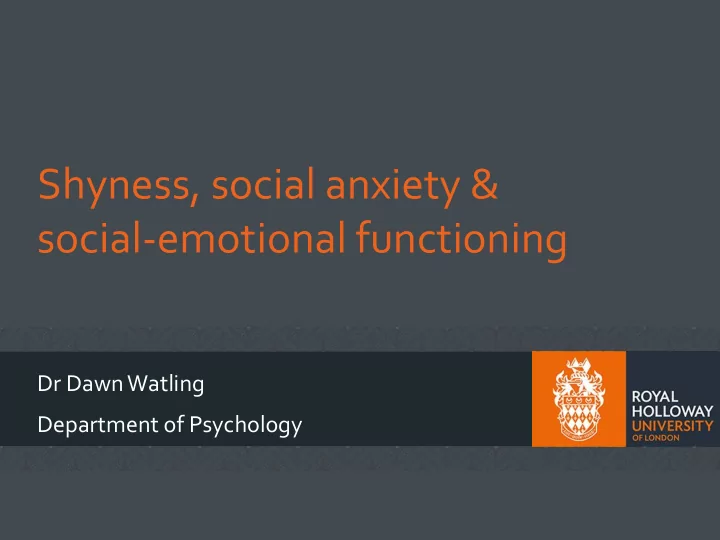

Shyness, social anxiety & social-emotional functioning Dr Dawn Watling Department of Psychology
Social Withdrawal Shyness, unsociability, and social avoidance Social anxiety Social phobia Social Anxiety Disorder is one of the most prevalent anxiety disorders with an estimated lifetime prevalence between 7% and 12% (NICE, 2013).
Shyness & Social Anxiety • Continuum of social fears in the general population (McNeill, 2010) Social ‘Normal’ Fears and Anxiety Fearlessness Anxieties Disorders
Social Anxiety Disorder in children How might children differ from adults (NICE, 2013)? • May be more likely to cry or ‘freeze’ or have behavioural outbursts such as tantrums. • May be less likely to acknowledge that their fears are irrational when they are away from a social situation. Aetiology of Social Anxiety • What factors influence the development of SA? • Rapee & Spence (2004): genetics, temperament, cognitive factors, social skills deficits, and environmental influences.
Social Anxiety Disorder Clark & Wells (1995) Does not see that the worst does not happen
How do children with higher levels of social anxiety interpret the world around them? • Discount positive events. • Catastrophize mild negative events. • Anticipate negative reactions to mild negative events.
Outcomes of social withdrawal behaviour Outcomes of social withdrawal • Poorer friendship quality, particularly as less intimacy and companionship. • Fewer social networks and friends, alongside poorer social skills. Friendships Social skills • Increased risk of school refusal, school drop out , and poorer school performance.
My focus Identifying what factors are related to social anxiety, with an aim to work with schools and clinicians in tackling ‘shyness’ before it reaches a clinical stage. Relationships with others Feelings of Safety social behaviours anxiety Emotion recognition
Relationships with others Importance of attachment relationships • Adolescents who have attachment relationships with their parents that are more trusting, and that are more alienating tend to have greater SA (41.1 % of variance accounted for). Parental Attachment Trust Communication Alienation +ve ns +ve Emotion Feelings ns Puberty processing of social -ve anxiety (Longinotti, Bourne, & Watling, in prep.)
Relationships with others Importance of attachment relationships • Children who have attachment relationships with their parents that are more trusting, and that are more alienating tend to have more SA (41.1 % of variance accounted for). • But what about peer attachments … parent alienation is significant until we add peer attachments to the model, then greater peer alienation predicts higher levels of SA (34% of variance accounted for). (Longinotti, Bourne, & Watling, in prep.)
Safety behaviours Self-presentation tactic use • Children high in SA use more self-presentation tactics, and do not discriminate between audiences (finding persists one year later; Banerjee & Watling, 2014). 70 • Findings maintained in adolescents 60 50 after controlling for depression and 40 mood (Dimmer & Watling, in prep). 30 20 • Greater tactic use was associated with 10 negative peer preference 0 Assertive Defensive Assertive Defensive Assertive Defensive Assertive Defensive 7 to 8 9 to 10 11 to 12 13 to 14 Low SA Med SA High SA
Safety behaviours: New directions Reputation management on social media… • Use of Facebook to manage reputations (does it work). • In an upcoming study, over the summer, we will assess how those high and low differ in their ‘sharing’ behaviour, while tracking eye-movements • I also have two new projects (one with adolescents and one with adults) that will look at reported Facebook use and how this relates to feelings of social anxiety. • Skype conversations • Just about to start a study to observe how socially anxious individuals use safety behaviours when engaging in a skype conversation
Emotion Recognition Recognition of facial expressions of emotion • Children and adults high in social anxiety have: • biases in emotion recognition • hypersensitivity to emotions • interpret ambiguous emotion as negative
Emotion Recognition: New directions Predicting emotion recognition over time: • Assessing how emotion recognition may be influenced by SA and laterality for emotion processing. • Can we influence the level of bias? • What features are important? • Exploring the role of hormones Figure from Brunet et al. (2009) (through adolescence), links with SA, and laterality for emotion processing.
Summary and implications • Children do not always exhibit shyness (and SA) as we would anticipate. • We should encourage shy and socially anxious youths’ social engagement with friends, but also with less familiar peers. • Important to work on an inclusive social environment. • Be aware that encouraging the use of safety behaviours is not generally helpful for those who are more socially anxious. • There is a bias in recognising negative or neutral emotions, which can affect reactions in social situations.
Focus on the individual… A framework for emotional and social development Materials endorsed by a team at RHUL, led by Professor Patrick Leman and myself • Materials written and developed by: Alastair Lidster (Educational Psychologist) and Becci Best (Assistant Psychologist), Beech Lodge School Launched 30 th June, 2016 • For more information see: www.fagus.org.uk
Thank you for listening. Please feel free to contact me with any questions: Dawn.Watling@rhul.ac.uk You can also visit the Social Development Lab website: http://www.pc.rhul.ac.uk/sites/social_development/site/ Or tweet: @SocDevLabRHUL
Recommend
More recommend